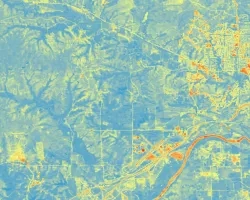Northern Brazil Agriculture (2024 Spring)
Team: Devon V. Maloney (Project Lead), Manpreet K. Singh, Grayson Shanley Barr, Sofya Goncharenko
Summary: As one of the largest agricultural exporters in the world, Brazil’s crop productivity is highly influential to the world’s food supply. Crop productivity across Brazil is heavily influenced by climatic factors, such as the El Niño-Southern Oscillation (ENSO), which drives spatially heterogenous effects on growing conditions. To understand the relationship between ENSO conditions and staple crop productivity, the team used 1984 – 2023 climatic data and vegetation indices for four Brazilian states: Bahia, Mato Grosso, Pará, and Tocantins. The team focused on soybean growing areas in each state derived from annual land use/land cover classifications. Monthly mean Normalized Difference Vegetation Index (NDVI) per state were calculated using multispectral imagery from the Landsat 5 Thematic Mapper (TM), Landsat 7 Enhanced Thematic Mapper Plus (ETM+), and Landsat 8 Operational Land Imagery (OLI) sensors. In addition, the team used crop production indices, ENSO anomalies, temperature, and precipitation data in this study. The team found that although monthly ENSO anomaly did have a positive relationship between temperature and a slight negative relationship with precipitation, ENSO and monthly soy NDVI were not significantly correlated. Results find no association between ENSO conditions and NDVI in the study area at the state level spatial resolution during the study period. Furthermore, the team found that there was no correlation between cumulative growing season soy NDVI and detrended soy production yield for this study region at the spatial and temporal scale of the analysis. Findings from this project will be used by the United States Department of Agriculture’s Foreign Agriculture Service to inform crop productivity forecasting.



